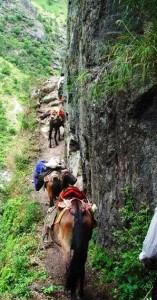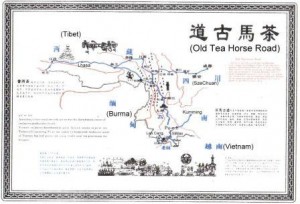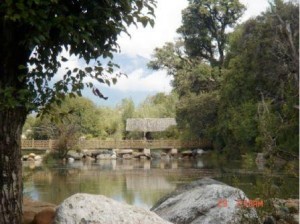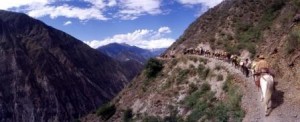Monday
Featured StoriesHorse Corridor in Heaven
From the column Shambhala at the Movies, by Angela Pressburger
Ode To The Ancient Tea-Horse Road
What is the name of that mountain; that mountain that lies ahead?
After we pass Changdu, we’ll get to Ya’an.
The butter tea of Batang is sweet; the zanba of Litang so tasty,
After passing Baxiu, Mangkang is at hand.
What is the name of that river, that river that lies ahead?
After we pass Zhongdian, we’ll be able to get to Lijiang,
Oh my pretty at Dali, my fragrant tea in Pu’erh,
The tea horse road is a long, long one; it leads you all the way to heaven.Anonymous, translated by Chu Daye
ASIAN CORRIDOR IN HEAVEN (English with Japanese subtitles. 2008, Korea/Japan, 360 min — six 60min. TV episodes)
This wonderful Korean TV series of adventure, hardship, wide open spaces and narrow escapes tells the story of the network of trading routes that developed along the southern Asian caravan trail(s), known as the “Ancient Tea-Horse Caravan Road”. The route crosses from the tea-producing areas of Southwest China’s Sichuan and Yunnan provinces, over mountainous terrain, into Tibet, Nepal, and India. This Caravan Road was not only an important route for the trade of tea and horses, but also a corridor connecting the languages, peoples, religions, and cultures along the way. The film explores these interrelationships against a magnificent background of the breathtaking scenery that brought this route so close to heaven.
The six episodes cover a number of topics that may be of particular interest to Shambhalians:
1. The Last Horse Caravan; 2. Road To Pilgrimage; 3. Tea of Life; 4. Chronicles of Tibet’s Salt Wells
5. Himalayan Salt Trek; 6. Guge: Mystery of The Lost Kingdom
The Ferghana horse is famed among nomad breeds.
Lean in build, like the point of a lance;
Two ears sharp as bamboo spikes;
Four hoofs light as though born of the wind.
Heading away across the endless spaces,
Truly, you may entrust him with your life…Tu Fu (China, 8th century AD)
Soon after the first emperor unified China in the 3rd century BC, the Chinese Empire began to look westward, towards Central Asia, both for trade, and for territorial expansion. An absolutely necessity in this great enterprise was good horseflesh – something China was sadly lacking, but which its nomadic neighbours, Mongols, Turks and Tibetans, possessed in great numbers. Above all, the Emperor desired the “Celestial Horses” of the Ferghana Valley in present-day Uzbekistan, as mounts for his warriors.
Diplomatic relations were established around 120 BC, and a gift of the magical Ferghana horses was sent to the Emperor Wu Di. The favour was returned with gifts of fine silk, a fabric unknown at that time west of the Pamirs. The exchange of silk and horses continued for some time, but in the 6th century AD, with its silk monopoly definitively broken, China needed a new way to pay for its “Heavenly Horses”. Fortunately, another export was discovered for which the peoples of Tibet, Mongolia and the Central Asian steppe, rapidly acquired an all-consuming taste – Chinese tea. The resulting tea-horse trade continued into the mid-20th century when “Operation Caravan” employed some 8,000 mules and over 20,000 yaks to carry supplies along the Tea-Horse road from Kalimpong to Lhasa, where they were repacked for delivery to Lijiang and thence to the British and American troops crowded into Kunming.
The Tibetan Connection
At about the same time as the Tang Chinese were developing a sophisticated tea culture, King Songtsen Gampo (604-650) unified Tibet and expanded its hegemony into Northwest Yunnan. He even conquered Lijiang and Dali by following an old caravan trail which would eventually become the southern Tea-Horse Road. Diplomatic relations were established with China in an effort to end military conflict. The Tibetan king requested the hand of a Chinese noblewoman and the Emperor sent his niece, Princess Wencheng of Tang, to marry the “barbarian” ruler. And so Chinese influences began to expand into the Tibetan court. In this way, tea first entered Tibet, as a luxury commodity. Within three decades the Tibetan aristocracy had taken to tea with great enthusiasm. By 1000 AD, it had become a staple.
Tea cannot grow at the high altitude of the Tibetan Plateau and importing it in quantities large enough to satisfy demand was a lengthy and difficult undertaking. In addition, the “shengcha” or green tea favoured by the Chinese court was impossible to keep green and fresh enroute, and so “zhuancha”, fermented Pu’erh tea, developed. The 3000 meter climb from Yunnan to the Tibetan plateau was difficult; the caravan horses, mules, yaks and human porters sweated a lot and the resulting moisture, combined with their body heat, furthered the tea fermentation process, so that the lightly flavoured tea bricks that left Yunnan continued to ferment along the road, developing a strong flavour which appealed to Tibetan tastes. Enroute, the tea changed from green to amber and eventually to dark teak, and the taste became livelier, richer, fruitier and smoother. During its months of travel, microbes acted on the tea, causing biological and enzymatic changes. The resulting tea, known to the Chinese as Pu-erh, became highly sought-after, first by royalty, high officials and the literati, and later by tea connoisseurs, not only for its unique taste, but also for its medicinal qualities.
 Availability
Availability
Available from KBS America, at the wonderfully low price of $19.99 for the 2 disc set of all six episodes. NTSC. Plays in Regions 1 (US & Canada), 4 (Brazil, Chile & Mexico), 5 (Eastern Europe, Russia, Africa, India)
Blu-ray 2 disc set, PAL, Korean with English subtitles, available for about 5 times the US price
Rental: Not Available
Further Reading:
Click here for a detailed review and photos of the expensive Blu-ray English subtitled Korean version.
Click here to read China’s ‘Ancient Tea-Horse Road’ in Historical Perspective a long, detailed and fascinating exploration of the subject



















